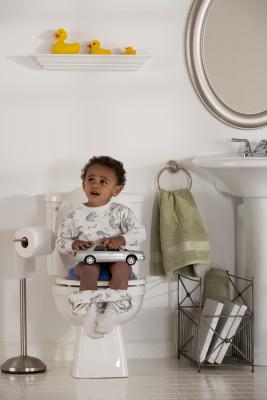The task of toilet training is rarely an easy one, and for parents whose child suffers from autism, this normally difficult task can seem next to impossible. If you are charged with the task of teaching an autistic child how to transition from diapers into potty usage, consider some ways in which you may be able to accomplish this task more effectively and with less stress and struggle. By taking your child’s autism into account when planning your potty training efforts, you can increase the likelihood of rapid and long-lasting potty-training success.
Step 1
Pick the proper time. The ability to communicate things like the need to go to the bathroom is vital for successful potty-training. Because your autistic child may not be as adept a communicator as a child who does not suffer from autism, you may need to wait a bit longer before your tackle the task of potty-training. Try to avoid rushing into potty training simply because you feel that your child is the appropriate age, and instead allow your child’s communication ability to determine when the proper time to begin potty training arrives.
Step 2
Create a kid-ready potty area. Many autistic children struggle when presented with change. The addition of a kid-toilet to your bathroom may be enough to send your autistic child on a tailspin. To ensure that this doesn’t happen, create your kid-ready potty area well before you intend to begin your potty training efforts. By setting up this space a week or so ahead of time, you allow your autistic child to become accustomed to the change before you ask him to modify his potty behavior.
Step 3
Chart your child’s bowel movement and urination practices. If you can identify a pattern in child’s diaper soiling, you can translate this pattern into a potty-training toilet time schedule, reports BBBAutism. As you wait for your tot to warm up to the potty training area, begin to chart her potty time patterns, writing down when she soils her diapers over the course of several days and looking for any consistency. If you find that some consistency exists, take advantage of this regularity.
Step 4
Determine what motivates your child. Because the task of learning to use the potty is generally more taxing for autistic children, these children commonly require additional motivation to do so. Consider your past reward systems and decide what you could use to motivate your child to put in this effort. Maybe your child enjoys receiving stickers on a chart, or perhaps he is more motivated by verbal praise. Whatever works for your child, put it to use as a motivational tool as you tackle this tricky task.
Step 5
Keep it consistent. While consistency is important with any child, this potty training principle is even more vital when potty training an autistic child. If you are constantly changing up your potty-time habits, your child will likely rebel against your potty training efforts even more than he already is. To avoid this, create a potty time routine and do not deviate from it, regardless of what may happen.





